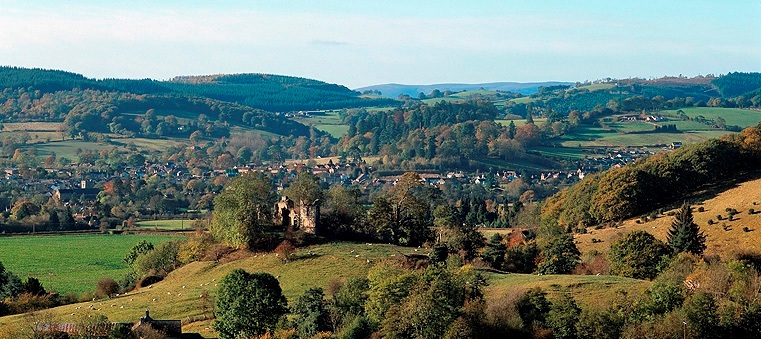The name given to the tight trousers worn by some Regency gentlemen, such as the notorious Beau Brummell and his ‘dandy’ followers, as they showed off their leg muscles.
PRESTEIGNE – ‘LLANANDRAS’ IN WELSH
When writer George Borrow came to Presteigne in 1867 he asked where he was – the reply was ‘Neither in Wales nor England, but simply in Presteigne, Radnorshire’. This small, but thriving border town, where one step over a small stone bridge will take you into England, is set amongst the lovely unspoilt countryside of the Marches and will delight you.
You can pick up a free copy of the town trail at The Judge’s Lodging, which will take you on a journey not only through the streets of this charming town, but also on a trip into the past. It will guide you by buildings such as The Red House, home of Rear Admiral Puget, after whom Puget Sounds, Vancouver, is named; The Radnorshire Arms Hotel, home of Sir Christopher Hatton (a favourite of Elizabeth I) and St Andrew’s Church which houses a superb 16th-century Flemish tapestry. Local archaeological treasures include standing stones, a holy well and the ruins of Stapleton Castle which look down over the town. You can also download the town trail here.
For nature lovers the town has a nature reserve, The Withybeds & Wentes Meadow and Silia Wood in which to wander. The discerning walker can walk straight from town to country on one of the many local paths, whilst the National trails of Offa’s Dyke, Mortimer’s Trail and Glyndwr’s Way all pass nearby.
WHILE YOU ARE IN THE AREA
From the town, a short drive will take you walking in the Brecon Beacons and the Elan Valley, sight-seeing and shopping in the picturesque border towns of Ludlow and Hereford, searching for books in Hay-on-Wye, or following the Black and White Village Trail around some of the most attractive villages in Britain.
If you want to know more about the town, have a look at the town website, where you will find ideas of things to do, a calendar of events, accommodation and much more.
We’re right on the Border here, so a stroll of just two minutes takes you into England.
Presteigne’s own town website is www.presteigne.org.uk
Knighton, our nearest Welsh town (6 miles)
Kington, our nearest English town (6 miles)
More on the history of Powys can be found here
Find out more about Mid Wales
Explore Wales’ built heritage with CADW – abbeys, house and castles…oh those castles!
